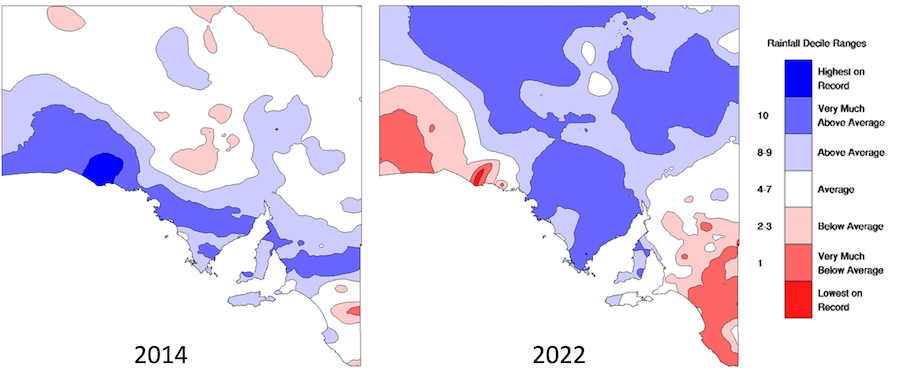The wet conditions over summer in 2021-22 and the resulting growth of weeds created a high risk for pests that could affect establishing crops in autumn.
Aphids thrive in these conditions as they survive over summer by taking refuge in small, isolated pockets of habitat (such as the green bridge). In addition to damage caused by direct feeding, these pests present the additional risk of virus transmission.
Significant numbers of aphids were already being reported in central New South Wales and Victoria in autumn 2022. While sharp drops in temperature in late autumn might have helped reduce their numbers, we could still see significant aphid issues at crop establishment. This article focuses on the green peach aphid; however, there are many other aphids that can cause direct damage and transmit viruses.

Summer rainfall was above average in areas of South Australia in 2014 and also in 2022. Images modified from the Bureau of Meteorology. Source: Cesar Australia
The green peach aphid (Myzus persicae) is a common pest of a wide range of broadacre crops, broadleaf pastures and horticultural crops throughout Australia, and they infest several broadleaf weed species.
Widespread insecticide resistance in the green peach aphid means that seed treatments and chemical solutions can be ineffective. Surveys by Cesar Australia in 2022 showed the main hosts in cropping systems were volunteer canola, wild radish, wild mustard, shepherd’s purse, clovers, medics and marshmallow.
Turnip yellows virus (TuYV, formerly known as beet western yellows virus) is transmitted by the green peach aphid and can cause serious disease in Australian canola crops. These aphids have a high transmission efficiency for TuYV (96 per cent) and can transmit it throughout their entire life cycle.
In 2014, South Australia, Western Australia and NSW experienced a large-scale crop virus epidemic, primarily affecting canola crops. Widespread infestations of green peach aphid in autumn and winter, the early start, and the early sowing of crops all contributed to the severity of this outbreak. In some areas, yield loss was as high as 75 per cent, with approximately 10,000 hectares of canola in SA severely affected by the outbreak.
Similar conditions (mild and very wet summer) to the 2014 outbreak were being seen in 2022, so it became important to keep an eye on green peach aphid and virus presence.
Early warning system
A TuYV early warning system, developed and led by Western Australian Department of Primary Industry and Regional Development researcher Ben Congdon, has been trialled in Victoria and southern NSW in canola paddocks since 2020. Yellow sticky traps were deployed by a network of agronomists and growers, with any aphids caught tested for TuYV using a rapid and sensitive RNA detection technique. In 2021, TuYV was detected in aphids at 94 per cent of sites, and in eastern Victoria this was accompanied by high TuYV incidence in crops. This warning system showed that despite dry starts and moderate green bridge risk in 2020 and 2021, there were still high numbers of virus-carrying aphids in autumn.
The high green bridge risk seen across southern Australia in 2022 indicated an increased threat for TuYV.
Management recommendations for TuYV and green peach aphids
Prevention of infection is the only successful management option, because TuYV cannot be sprayed out post-infection.
The following strategies can be used to minimise aphid numbers and reduce virus risk:
- ensure canola paddocks are weed-free for at least 10 days prior to sowing and reduce the green bridge as much as possible surrounding it;
- do not sow crops early in the season – sow on usual dates, to avoid early aphid flights;
- conduct regular monitoring for green peach aphids from sowing to stem elongation;
- where possible, sow into standing stubble – aphids prefer to land on bare earth and are less likely to move into crops in standing stubble until after the rosette stage; and
- consider the use of a selective insecticide during the critical period (April to June) if large numbers of green peach aphid are detected in crops.
If you notice TuYV symptoms, get tested
Testing for TuYV is recommended if any symptoms (such as leaf purpling) occur. Similar symptoms can occur due to other reasons (including nutrient deficiency), so testing is required to confirm. It is critical to report TuYV information to better predict and manage outbreaks. TuYV testing is available through Agriculture Victoria or the NSW Department of Primary Industries.
More information: Green peach aphid identification video; Green peach aphid best management practice guide; Agric 2014 turnip yellows virus symptoms and management
Acknowledgements
The TuYV early warning system is part of the DPIRD ‘Boosting Grains’ project 2019SP02, led by DPIRD research scientist Dr Ben Congdon in collaboration with Cesar Australia and supported by GRDC. Cesar Australia and DPIRD acknowledge all participants involved in the TuYV early warning system.

























































